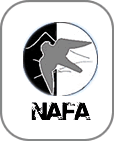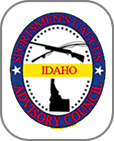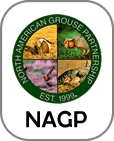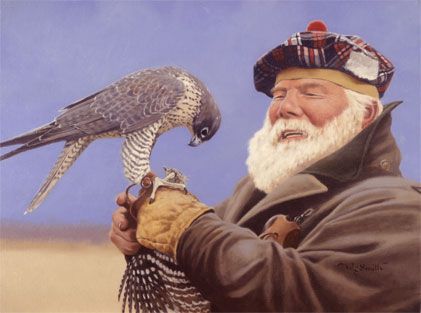A Brief History of Falconry in North America
With the origins of falconry elsewhere in the world going back at least to the third millennium BC, North American association with the sport can only be termed as brief. We can find no tangible evidence of any practice of the sport by the native peoples here. Even though Columbus had at least one falconer in his party who reportedly hunted with his hawks prior to 1500 in what is now Haiti, falconry here long remained a rarity. Brief practice by the Spanish conquistadores in Mexico and even an early New England pilgrim-falconer really had little if any lasting influence. North American records of those attempting to practice the sport, through the 18th and 19th centuries are rare indeed and those to whom we have been able to find reference were widely scattered both geographically and in time. Although we may have missed some records, such general absence in the historical record more likely reflects both a lack of any significant measure of interest as well as participation in falconry on the continent during that period.
A handsomely illustrated article in the National geographic magazine for December, 1920 aroused an interest in some and provided ready reference in an era when falconry books were both expensive and hard to find on this side of the Atlantic. By the 1930’s we find a growing interest in the sport, especially among young men associated with eastern universities. Significantly, without the long hawking tradition that existed elsewhere in the world, falconry here found an appeal not so much within the North American hunting fraternity as among those with an interest in nature and natural history. It is noteworthy too, that stemming from a natural history rather than a hunting background, most North American “falconry” of that era consisted far more of possession than of actual hunting. Much of that trend can be traced to the glorification of the peregrine falcon in the then-available literature and the comparatively ready access to those birds which commonly, for a falcon, nested in the eastern U.S. The drawback: neither the terrain nor the quarry readily available in that part of the continent were suited to active hunting with peregrines, hence much more having than hunting.
Late in that decade, the discovery of peregrines migrating along the barrier islands of the eastern U.S. caused a significant shift in American falconers’ approach to their sport. From an orientation pointed almost entirely toward the use of young birds removed from the nest, many American falconers began to trap their own passage hawks, not just peregrines but, with lessons learned on those eastern barrier islands, migrants of a variety of suitable species. In contrast, where passagers were used in Europe, for the most part, they were obtained from professional trappers, resulting in few local falconers actually participating in their trapping. The result was a circumstance differentiating North American falconers from their European brethren which continues to this day.
By the end of the thirties and early forties a series of articles by John and Frank Craighead, themselves destined to gain fame in a variety of natural history and conservation venues, fueled an increasing interest in the sport. Their account of a trip to India and the falconry they encountered there was the thing of which American falconers could only fantasize. Still, by the beginning of World War II, the number of falconers known in North America was less than 200.
Travel resulting from that war, along with the ensuing advances in communications, attracted increased numbers to falconry and facilitated contacts among them. That expansion was further enhanced by the appearance of numerous – if sensationalistic – articles in popular magazines. While many of those initially enamored with the sport through that media fell by the wayside when faced with the realities of keeping, much less hunting with a raptor, the number of serious devotees expanded.
Up until the 1950’s falconry had received little legal attention. In most states and provinces the majority of raptors were unprotected and in some instances bounties were offered for their killing, their possession thus being unrestricted. Falconry was commonly omitted from regulations listing ”means” legal for taking game – not due to any opposition to the sport but simply because falconry was too little known even to be considered. To their credit, falconers took a proactive role in seeking legalization of their sport and its sensible regulation. In these early efforts we see a distinct if not unique advantage North American falconers enjoyed, an advantage stemming from their natural history orientation already noted. With such orientation many falconers had become professionally involved in ornithology and wildlife management and hence were in a position to credibly represent the sport from a biological point of view. They were simultaneously motivated to work toward a scientific appreciation involving the long-needed conservation of raptorial birds. In both aspects their efforts and representation are reflected in current laws and regulations.
Almost from its beginnings, and despite the tendency of falconry to attract individualists, local falconry clubs began to appear. Often begun on a strictly informal, social basis, many evolved into a means by which to influence falconry-associated legalization and regulation, and a few extended to a national level. Nationally these organizations, though often short-lived, were a reflection of the personality (and ego) of strong-minded adherents to the sport. The most notable of these was Captain (later Colonel) R. Luff Meredith. A retired military (Air Corps / Air Force) officer, Meredith had developed an active devotion to the sport early in the twentieth century. With his age and experience, he was admired by many who came later. Directly involved in two of North America’s earliest national falconry organizations – he is today considered the “Father of American
Falconry”.
By 1961, with numbers of American falconers considerably expanded (at least comparatively) and with Meredith aging and ill, the North American Falconers Association (NAFA) was formed. While on occasion enmeshed in some of the same personality issues as its predecessors, NAFA has weathered such issues and is today a solid, permanent, continent-wide representative of the sport. The current, enviable status of falconry nationally can be traced directly to efforts orchestrated by this organization. One immediate impact on the sport here directly attributable to NAFA occurred at the organization’s first “field meet” in Reno, Nevada in 1962. Over the period of the meet and before its assembled membership, two young California falconers, Louis Davis and Jimmy Adamson, flying a west coast peregrine and a European goshawk, respectively, consistently took wild quarry with their birds Davis even taking three California quail over a single point. While scattered others had taken wild game in the past, the hunting instead of just having, birds of prey that Davis and Adamson demonstrated before so collected an audience convinced many who witnessed it that indeed, beyond all the books and all the talk, falconry could truly be a hunting sport. Few single events have had such a profound and long-lasting effect on the practice of falconry on the continent.
The 1960’s saw other events that had a major significance on how the sport was practiced here. First falconers and then scientists became aware of marked declines in nesting populations of our native peregrine falcons, a situation most especially evident in the east. A 1965 scientific conference on this population disaster gathered those most familiar with the species to document and then discover the cause, and, to find a solution to this problem (The cause was eventually determined to be the result of persistent pesticides.) Many of the participating “experts” were falconers.
Despite the fact that by then most falconers’ peregrines were passagers (wild birds captured during their first year) taken on migration, to some “knee-jerk conservationists” the falconers were to blame for the population decline: falconers take peregrines, peregrines were declining, ergo, falconers must be the cause of the decline! In contrast, falconers were unwilling to accept the extinction of the species – and they did something about it! Again, our natural history origins played an important role. Falconer-scientists, chief among them Professor Tom Cade, then Director of Research at Cornell University’s prestigious Laboratory of Ornithology, gathered together in search of a solution.
Aided by a dedicated group of graduate and post-doctoral students – falconers all – and with the support of three others best described as “hard-core falconers” Cade formed the Peregrine Fund. Using falconers’ birds, techniques, and money – but most of all falconers’ passion – that group learned to breed the species in captivity, to breed them in numbers, and then to successfully release them into the wild. In so doing they played the major role in the most significant endangered species recovery of the 20th century, the return of the peregrine falcon in North America. The importance of the Peregrine Fund’s role was exemplified by the fact that when time came to remove the peregrine from the endangered list the U.S. Secretary of the Interior flew some 2000 miles from Washington D.C. to announce that recovery at The Peregrine Fund’s Boise interpretive center. The importance of the role of falconers in this conservation effort cannot be overstated. Recognition of that role, particularly in circles previously opposed to the sport, did much to enhance the status of the sport and to elevate falconers to a position well above just “users” of wildlife.
It seems likely that along with the growing appreciation of the value of our bird of prey population, the attention drawn to peregrines, ospreys, and bald eagles in the pesticide crisis helped influence a U.S. government decision to assume federal (as opposed to the former state) jurisdiction over raptors by adding them to the Migratory Bird Treaty in 1972. That change was particularly significant for falconers’ (NAFA’s) efforts toward legalization of the sport by providing a single, federal point upon which to focus efforts, rather than having to work state by state as they had previously.
By the time that raptor jurisdiction went from state to federal hands NAFA had already been active in developing a model state law / regulation aimed at developing better and more consistent country-wide raptor management and falconry regulation. NAFA’s recommendations were accepted by the International Association of Game and Fish commissioners, thus it was not surprising when the U.S, Fish and Wildlife Service used the NAFA proposal as a basis for new federal falconry regulations. It took about four years to arrive at a final rule. The falconry community with guidance from NAFA did an exemplary job of providing input to the federal authorities. The falconry community generated more comment letters supporting the proposed regulations than “The Service” had ever received on any single issue - before or since. Those regulations fostered considerable development of the sport, and despite being admittedly stringent, they are highly regarded internationally.
NAFA has officially represented falconry in discussions with federal officials and provided guidance to various affiliates at the state level, supporting efforts toward legalization, regulations, seasons, etc. Lessons learned by NAFA were able to help local clubs in similar efforts throughout the country. The success of this approach resulted in the legalization of falconry in 49 states. (Hawaii, with its only indigenous hawk on the endangered list and with imports of non-native raptors prohibited, is the one state where conduct of the sport is not feasible).
An incident culminating in 1984 at first appeared to threaten the good standing of the sport in the United States and Canada. The Law Enforcement Division of the U.S. Fish and Wildlife Service became convinced that there existed a multi-million dollar illicit trade in falcons conducted between North American and Middle Eastern falconers. A major “sting” operation was undertaken. Unable to find any falconers offering illicit birds, The Service took a number of gyrfalcons and then-endangered peregrines from the wild and used them as “bait” in entrapment actions. The Service was unable to substantiate its claims since no illicit market existed except for the one they created. The Law Enforcement Division suffered a considerable humiliation. Unfortunately, falconers still suffer from the aftermath of this federal debacle. Given the spectacular nature of law enforcement claims when our imagined transgressions were revealed, there remain some who still today, despite all the evidence to the contrary, view us as representing illicit commercial motives.
Because of their long-established, historic traditions, North American falconers have been inclined to “push the envelope” rather than simply follow past practices in lock-step. Perhaps for that reason five of the six major advances in the sport occurring in the 20th century originated in North America, specifically:
- The development of captive breeding techniques, including the creation of hybrids, which provides a source of birds for use in the sport. These techniques are now used in raptor conservation efforts.
- The development of radio telemetry which facilitates recovery of lost hawks and allows falconers to fly their birds in heavier, healthier, and more effective condition. The latter has had a significant effect on the quality of the sport seen here today.
- Development of the “American hood”, with its thin leather, exceptional workmanship, and beak-opening conforming to the natural contours of the falcon’s head – the most significant advances in hood making in the preceding millennium.
- Discovery of the cause, and then cure, for the ancient, lethal falcon’s disease of “frounce” (trichomoniasis).
- Introduction of the Red-tailed Hawk and Harris’ Hawk into international falconry.
The sixth major 20th century advance was the development by British falconer Guy Aylmer of the “Aylmeri jess”.
Following the final establishment of those first U.S. federal falconry standards in 1976, falconry in North America has continued to expand and improve significantly, not so much in numbers (the very nature of the sport is itself self-limiting) but in quality. The 1970’s saw the revival of the sport in Mexico and ensuing decades have seen a steady expansion of its practice. A number of local clubs are now established, meets are held, and efforts toward improved raptor conservation and falconry regulation are being undertaken. In Canada there is no federal oversight, thus there is considerable variation in the practice of the sport between provinces. These variations range from outright illegality to provisions as generous as any in the U.S. Certainly the quality improvement of falconry in the United States has been equaled in Canada, but on a smaller scale given that there is a much smaller population of falconers. In all three countries, example, regulation, peer pressure, and opportunity have combined to produce a standard of falconry which all of its participants can be proud. We have as fine a state of falconry in North America as anywhere else in the world.
Today we find falconry in North America in a healthy and encouraging position. A lengthy review and revision of the federal falconry standards has been accomplished and approved by the states and the federal government. Not only has the peregrine falcon been removed from the federal endangered designation and the take of nestling birds been approved, but a significant passage peregrine take has been implemented. The role of falconers in conservation becomes increasingly appreciated and NAFA, approaching some 2000 members, is on a solid foundation as it continues to represent our sport.
(A special thanks to Kent Carnie, Founder / Curator Emeritus, The Archives of Falconry for this article.)
Idaho Beginnings
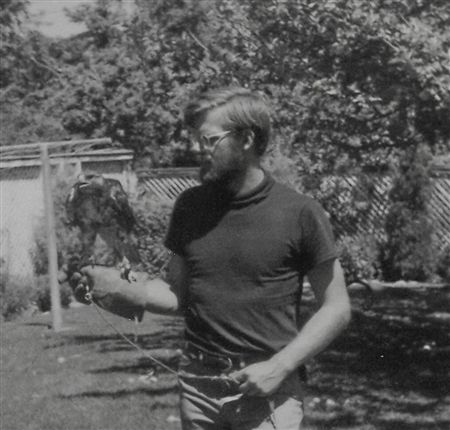 Photo of Rich Howard circa 1969
Photo of Rich Howard circa 1969For several years, during the late 1970s individuals and small groups of falconers had been attempting to get some desired changes in the Idaho falconry regulations , such as longer hunting seasons. After these initial attempts failed, a serious discussion was started by some of the more active Idaho falconers in both the eastern and the southwestern part of the state, that maybe a better approach would be to form an association or club to represent their common desires. There was, at that time , as with many other states, a reluctance to forming a state wide organization. It was felt that the North American Falconers Assoc (NAFA) was enough. After several discussions with such individuals such as Charles Schwartz, Richard Howard, Todd Shepherd and others, ,In April 1977, Jesse Woody, the Director-at-Large for NAFA and Charles Schwartz sent out a letter to licensed falconers around the state requesting their view, on longer seasons, standardizing Fish & Game Department policies on captive breeding and the possible support of a state falconry organization.
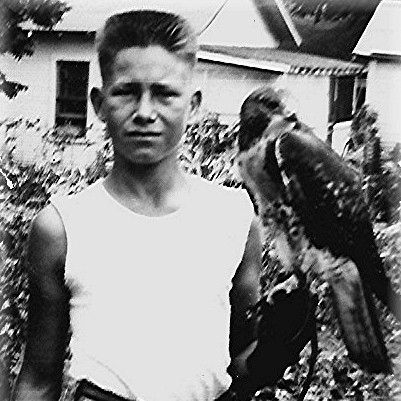 Photo of Jesse Woody circa 1954
Photo of Jesse Woody circa 1954Woody also wrote Will Godfry, the Chairman of the Idaho Fish & Game Commission seeking support for the Idaho falconers request for longer seasons. The response from the Commission was positive, but it was suggested that falconers should have a more organized approach to the request. The response from falconers was low, but those who did respond, supported the concept of a statewide club organized for informational and political purposes only. Elected regional spokespersons and a newsletter would keep members informed.
On June 20, 1978, Todd Shepard of Pocatello, as acting coordinator, sent out a letter explaining that over 50% of the Idaho falconers supported the action suggested in the April inquiry, declared the formation of a statewide club and dubbed it the Idaho Falconers Association. All recipients of the letter would be considered members unless a written refusal was sent to Todd within 10 days. A draft copy of the Constitution , written by Charles Schwartz was included. The Idaho Falconers Association was born!
